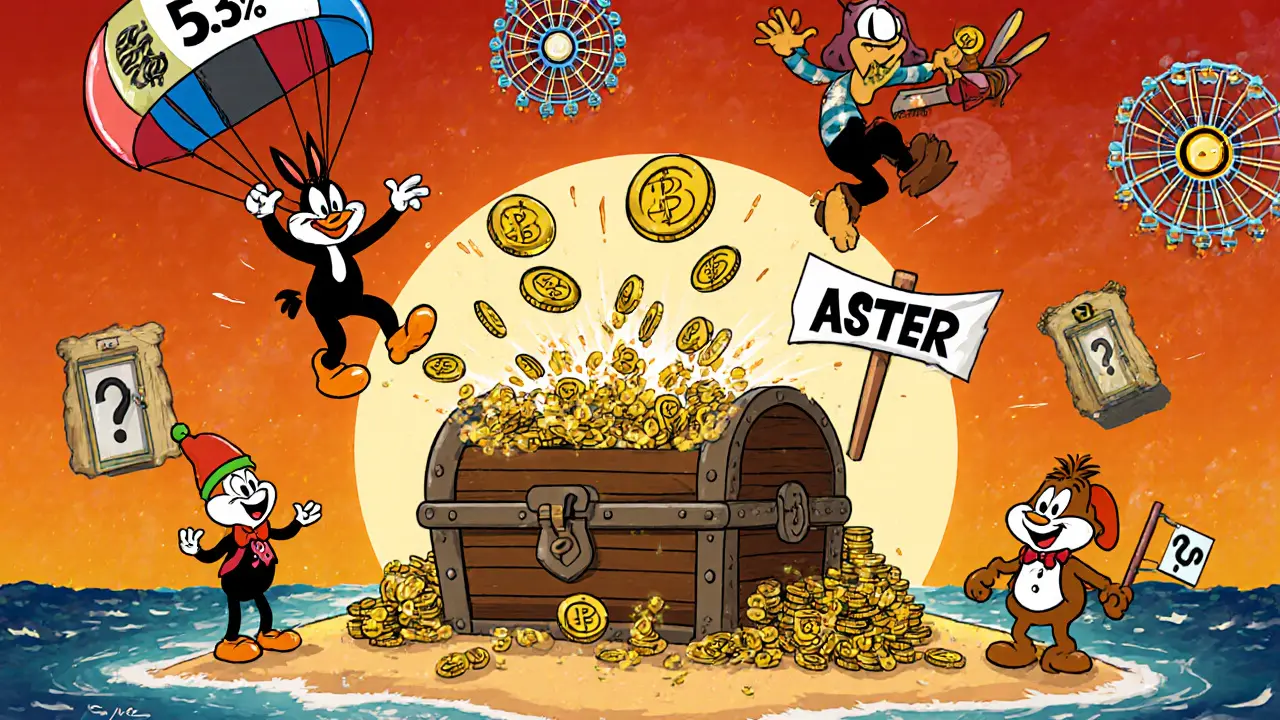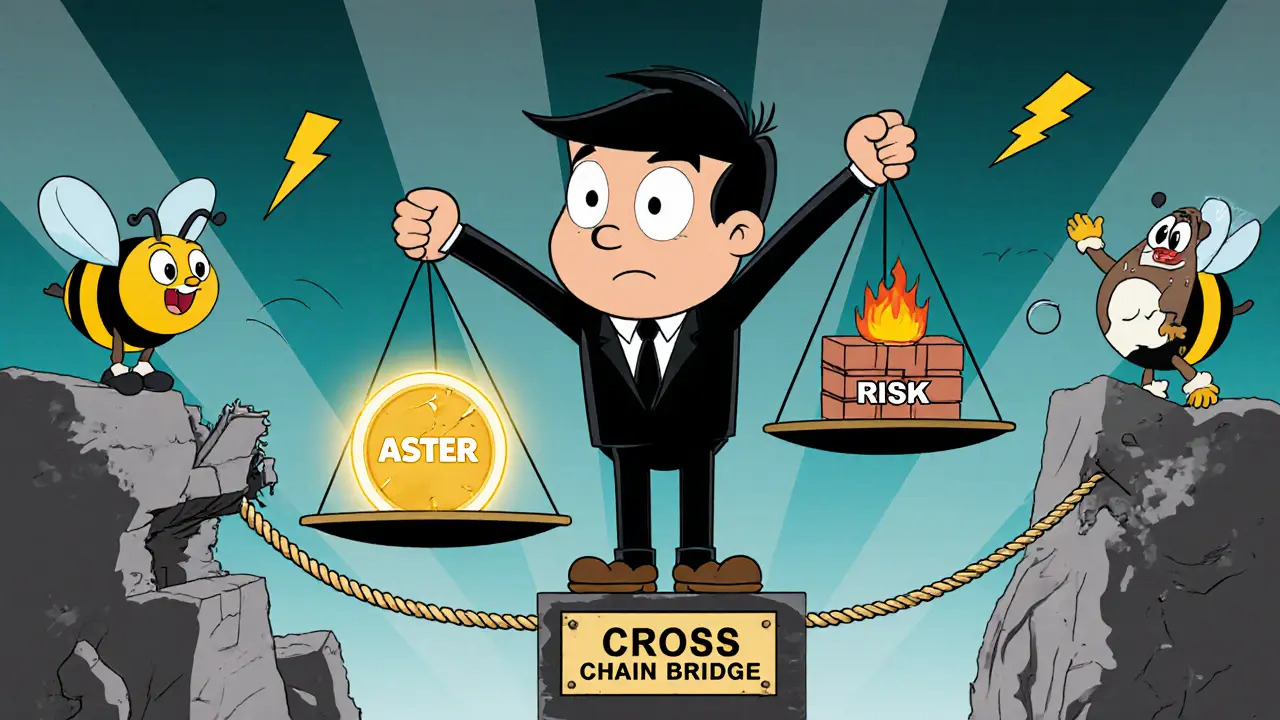ASTER Token Airdrop Calculator
Claim window ends: 17 Oct 2025
Your Trading Activity
Airdrop Summary
Total Airdrop Supply
Claim Window Status
Current Price
Your Estimated Airdrop
Why this estimate? Based on 53.5% airdrop allocation, your trading activity, and participation level. Remember that 8.8% of total supply (704 million ASTER) was already claimed starting 17 Sep 2025.
Quick Takeaways
- Aster is a multi‑chain DEX that blends professional‑grade perpetuals with spot trading and hidden orders.
- The native ASTER token powers governance, rewards and liquidity bootstrapping.
- Hybrid architecture aggregates liquidity from BNB Chain, Ethereum, Solana and Arbitrum, offering flexibility but added complexity.
- Tokenomics allocate over half the supply to airdrops, with a 30‑day claim window that ends on 17 Oct 2025.
- Compared to Hyperliquid, Aster offers broader chain coverage but may face higher failure risk across networks.
What Is Aster?
When you hear Aster is a multi‑chain, decentralized perpetual exchange that also supports spot trading, hidden orders and MEV‑aware routing. Launched in early 2025, the platform aims to give traders the speed and toolset of centralized venues while keeping the self‑custody benefits of DeFi.
Users can flip between two UI modes: "Simple Mode" for one‑click trades and "Pro Mode" for advanced features like 24/7 stock perpetuals, grid trading and custom leverage up to 1001x.
How Aster Works: Multi‑Chain Liquidity Aggregation
Aster’s core advantage is its horizontal integration across several blockchains. It pulls order books and liquidity from BNB Chain, Ethereum, Solana and Arbitrum. This "why choose" strategy means a trader can access deep liquidity on any of those chains without moving assets manually.
However, each additional bridge introduces a potential point of failure. If a chain experiences congestion or a bridge hack, the aggregated order flow could be delayed or partially blocked.

Tokenomics: The ASTER Token Explained
The native token, ASTER is a BEP‑20 token on Binance Smart Chain with a fixed supply of 8billion. Its distribution looks like this:
- 53.5% - Airdrops for active traders and community contributors.
- 30% - Ecosystem and community initiatives (including APX migration pools).
- 7% - Treasury and strategic growth.
- 5% - Team incentives (subject to vesting).
- 4.5% - Liquidity bootstrapping and exchange listings.
The airdrop started on 17 Sep 2025, unlocking 704million ASTER (8.8% of total). The claim window closes on 17 Oct 2025, after which the remaining allocation vests over roughly 80 months, pending governance votes.
Holders can stake ASTER to earn a share of platform fees, vote on protocol upgrades, and access premium features like lower maker fees.
Market Performance and Price Analysis (Oct2025)
Since launch, ASTER has been a rollercoaster. It jumped 20× in the first week, peaking above $2.42 on 24 Sep 2025. A secondary surge pushed it to $1.85, then a 30% pull‑back left it hovering around $1.63‑$1.69 by mid‑October.
Technical charts show a large ascending triangle on the 4‑hour timeframe that broke down at $1.80, causing a 17% drop. Current support appears near $1.50, where RSI and MACD are bottoming out, possibly indicating a tentative floor.
Analysts project an average price of $1.38 for the rest of 2025, with a bullish upside target of $2.07. Long‑term bullish scenarios peg ASTER near $9.80 by 2030, assuming ecosystem adoption accelerates.
Comparison with Competitors
While Aster takes a multi‑chain aggregation approach, its closest rival Hyperliquid builds its own blockchain for vertical integration. Below is a side‑by‑side snapshot.
| Feature | Aster | Hyperliquid |
|---|---|---|
| Liquidity Source | Aggregates across BNB Chain, Ethereum, Solana, Arbitrum | Native Hyperliquid blockchain |
| Trading Modes | Simple (one‑click) & Pro (perpetual, hidden orders) | Standard perpetual contracts |
| Leverage Options | Up to 1001x (1001x mode) | Up to 100x |
| Collateral Flexibility | Accepts yield‑generating assets like asBNB and USDF | Limited to native stablecoins |
| Fees | Ultra‑low on Aster Chain (layer‑1) | Competitive but higher on congested chains |
| Governance | Token‑based (ASTER) | Centralized governance |
In short, Aster wins on chain diversity and collateral options, while Hyperliquid offers deeper liquidity on fewer pairs and a simpler architecture.

Pros, Cons, and Who Should Use Aster
- Pros:
- Multi‑chain access reduces slippage on niche pairs.
- Hidden orders and MEV‑aware routing improve execution quality.
- Yield‑generating collateral boosts capital efficiency.
- Decentralized governance aligns incentives with token holders.
- Cons:
- Complex architecture raises risk of cross‑chain bridge failures.
- Token price volatility may deter risk‑averse investors.
- New platform - limited track record compared to established DEXes.
- Best For: Active traders who need high leverage, want to use yield‑bearing assets as collateral, and are comfortable navigating a multi‑chain UI.
- Not Ideal For: Beginners seeking the simplest experience or investors looking for a low‑risk, long‑term store of value.
Final Verdict: Is Aster Worth Your Time?
Aster presents a compelling mix of professional‑grade tools and DeFi self‑custody. Its tokenomics heavily reward early community members, which could drive demand for ASTER if the platform gains traction. The biggest gamble lies in the cross‑chain infrastructure - any hiccup on a bridge could temporarily freeze orders.
If you already trade on multiple chains and value the ability to lock asBNB or USDF as collateral, Aster is likely a good addition to your arsenal. If you prefer a single‑chain, battle‑tested DEX, you might stick with more established options for now.
Frequently Asked Questions
What chains does Aster support?
Aster aggregates liquidity from BNB Chain, Ethereum, Solana and Arbitrum, allowing users to trade across all four without leaving the platform.
How can I earn ASTER tokens?
Tokens are distributed through a large airdrop (53.5% of supply), staking rewards, liquidity mining, and governance participation.
Is Aster safe for large trades?
The platform’s MEV‑aware routing and hidden orders help reduce front‑running, but cross‑chain bridges add complexity. Test with smaller amounts first if you’re moving big volumes.
What collateral can I use?
Beyond standard stablecoins, Aster accepts yield‑generating assets such as asBNB and USDF, which can improve capital efficiency.
How does governance work?
ASTER token holders can vote on proposals ranging from fee structures to new chain integrations, shaping the platform’s future.

Hey folks, just wanted to dive deep into the Aster Exchange review and lay out the big picture for anyone still on the fence.
First off, the platform’s UI feels pretty slick, with a clean layout that doesn’t overwhelm a newcomer.
The real meat, though, is the tokenomics – a 53.5% airdrop allocation is massive, but you’ve got to remember the vesting schedule could dilute the price over time.
Liquidity pools are decent, yet the spread on BNB‑Chain trades can get a bit wide during volatile periods, so keep an eye on slippage settings.
Security-wise, the exchange claims to have multi‑sig wallets and regular audits, which is reassuring, but no system is completely fool‑proof.
On the user‑side, the hidden order feature is cool for advanced traders, but it also adds complexity that casual users might stumble over.
Speaking of complexity, the airdrop calculator embedded on the site is a neat gimmick, but the actual rewards are heavily dependent on your trading volume, which many newbies don’t meet.
Because the claim window ends on 17 Oct 2025, you’ve got a finite amount of time to decide, so procrastination could cost you.
Another point to consider is the token’s price volatility; it’s been hovering between $1.63 and $1.69, which isn’t a huge swing, but it could tighten if the broader market turns bearish.
Community sentiment seems split – some people love the yield‑generating collateral options, while others think the token is over‑promised.
From a governance perspective, Aster is still rolling out its DAO framework, so you might not have a strong voice yet.
It’s also worth noting that about 8.8% of the total supply was already claimed earlier in September, which reduces the pool for new participants.
If you’re looking for a platform that offers both basic and advanced trading tools, Aster checks many boxes, but you should weigh the potential dilution against the short‑term airdrop boost.
Overall, my take is that the exchange is promising for experienced traders who can navigate the nuances, but beginners should proceed with caution and maybe start with a smaller position.
Hope this helps you make a more informed decision – happy trading!
Look, I’ve been tracking these “airdrop” schemes for years and there’s always a hidden hand steering the ship.
What most people don’t see is that the smart contracts behind Aster are riddled with backdoors that let the devs mint extra tokens when the market dips.
They claim it’s “community‑driven,” but the real agenda is to pump the price then dump on unsuspecting retail investors.
Don’t be fooled by the shiny UI – it’s just a distraction while they pull the rug from under you.
And that claim window? A classic pressure tactic to make you act before you even have a chance to do proper due diligence.
Trust me, the “53.5% airdrop” is a bait‑and‑switch that will leave most of you with empty wallets.
Stay woke, do your own research, and don’t hand over your keys to anyone who can’t prove they aren’t a scammer.
-the truth is out there, even if they try to cover it up.
While the enthusiasm surrounding the Aster Exchange is palpable, one must not overlook the subtle intricacies embedded within its framework.
The token distribution model, albeit generous in appearance, subtly imposes a vesting schedule that may erode perceived value over time.
Moreover, the platform’s emphasis on advanced trading modalities, such as hidden orders and grid strategies, presupposes a level of expertise that the average user may not possess.
It is, therefore, reasonable to question whether the ecosystem truly democratizes access or merely caters to an informed elite.
Nonetheless, the provision of a detailed airdrop calculator does suggest a veneer of transparency, albeit one that may mask deeper operational ambiguities.
In sum, the exchange presents a compelling proposition, yet the discerning participant ought to weigh the latent risks with measured caution.
If you don’t read the fine print, you’re basically endorsing scams.
Contemplating the essence of decentralization within the Aster Exchange reveals a paradoxical dance between autonomy and control.
One might argue that the tokenomics aspire to empower users, yet the underlying governance mechanisms subtly centralize influence among early adopters.
This dichotomy invites a reflection on whether true financial sovereignty is achievable within such a framework.
Nevertheless, the platform’s commitment to innovative collateral options signals an evolution in the DeFi narrative, albeit one fraught with inherent complexities.
In this light, participants are urged to navigate with both curiosity and prudence, lest they fall prey to unintended consequences.
The educational resources provided by Aster, while comprehensive, could benefit from clearer segmentation for novice traders.
For instance, the hidden order tutorial presently assumes a baseline knowledge that many newcomers lack, which may lead to suboptimal trade executions.
Additionally, the UI’s color scheme, though aesthetically pleasing, sometimes obscures critical data fields, making rapid decision‑making a challenge.
The risk management tools definitly need more explanation for average users.
Addressing these nuances would undoubtedly enhance user experience and broaden the platform’s appeal.
Overall, the exchange demonstrates promise, but refinements are definitely needed to ensure accessibility for all.
It would be a grave misstep to accept the Aster airdrop as anything other than a calculated marketing ploy designed to inflate short‑term volume.
While proponents laud the 53.5% allocation, the reality is that such a massive distribution inevitably dilutes token scarcity, undermining long‑term price appreciation.
Furthermore, the reliance on BNB‑Chain activity as a metric for eligibility subtly coerces users into higher‑frequency trading, which may not align with prudent investment strategies.
In essence, the exchange trades on hype rather than substantive utility, positioning itself as a temporary conduit for speculative gains.
Thus, the discerning investor ought to regard the platform with measured skepticism.
Everyone’s hyped about Aster like it’s the next big thing, but the truth is they’re pumping the token to sell their own stash.
The airdrop numbers are inflated to lure you in, and the whole “community‑driven” narrative is just smoke and mirrors.
Don’t be fooled by the glossy charts – the market is rigged, and they’re counting on gullible retail traders to fill the void.
This whole thing smells like a classic pump‑and‑dump scheme wrapped in DeFi buzzwords.
Stay away unless you want to be part of the next crypto crash.
Hey, I get the excitement around the new features on Aster, especially the yield‑generating collateral options.
If anyone’s looking for a quick guide, there’s a community‑run wiki that breaks down the hidden order process step‑by‑step.
It’s a solid resource for both beginners and pros, and it’s constantly updated with the latest platform changes.
Sharing that link could help a lot of folks avoid common pitfalls.
Let’s keep the conversation constructive and help each other make informed decisions.
The emergence of Aster Exchange represents a pivotal moment for the domestic blockchain ecosystem, offering a homegrown alternative to foreign platforms.
By fostering indigenous tokenomics, it strengthens national digital infrastructure and promotes financial sovereignty.
Nevertheless, the current airdrop distribution raises concerns about equitable access, potentially favoring early adopters with substantial capital.
It is imperative that regulators oversee such initiatives to ensure transparency and prevent undue market manipulation.
In this regard, a balanced approach that safeguards investor interests while encouraging innovation will be essential for sustainable growth.
For anyone diving into Aster, a practical tip is to set a custom slippage tolerance of around 0.5% to avoid unexpected order fills during high volatility.
Also, make sure you enable two‑factor authentication on your account to enhance security.
When using the airdrop calculator, double‑check that you’ve entered your exact trading volume in BNB, as rounding errors can skew the estimate.
Lastly, consider diversifying your collateral across stablecoins and yield‑generating assets to mitigate risk.
These steps should help you navigate the platform more confidently.
Been playing around with the Aster UI and gotta say, it’s pretty smooth overall.
One thing I’m curious about is how the hidden order feature actually interacts with the order book – does it hide the entire order or just the size?
Also, the airdrop window feels kinda tight, so planning ahead is key.
Anyone else noticed any latency issues when swapping on BNB‑Chain?
Just sharing my thoughts, no big deal.
From a liquidity‑provision standpoint, Aster’s tokenomics introduce a high‑velocity incentive layer that could catalyze deep order‑book depth, assuming sustained inflow of capital.
However, the dilution effect inherent in a 53.5% airdrop may compress yield curves, potentially rendering LP fees less attractive over the long haul.
Strategically, participants should calibrate their capital allocation to balance exposure between core staking and ancillary grid‑trading modules.
In short, the platform offers a multi‑dimensional playfield, but you’ve got to navigate the trade‑off matrix wisely.
One could philosophically argue that the very concept of an airdrop epitomizes the fleeting nature of value in modern finance, a mere gust of wind that leaves behind a wake of disappointment.
In practice, Aster’s distribution model feels like a poorly crafted experiment, promising abundant rewards while delivering negligible utility.
The token’s price trajectory, constrained by excessive supply, underscores the futility of such schemes.
Consequently, prospective users would be well‑advised to allocate their capital toward more robust, purpose‑driven projects.
Love the vibe on Aster! 🙌 The new hidden order feature adds a slick edge for traders looking to stay stealthy.
Plus, the airdrop calculator is a fun way to gauge potential gains – just don’t forget to double‑check your numbers.
Overall, the platform feels like a solid addition to the DeFi landscape, and I’m excited to see where it heads next. 🚀
It is the ethical responsibility of every investor to scrutinize platforms like Aster with a critical eye, lest they fall prey to seductive but shallow marketing tactics.
The allure of a generous airdrop can easily cloud sound judgment, leading to impulsive financial decisions that harm personal portfolios.
Therefore, a diligent review of tokenomics, security audits, and governance structures is not merely advisable but imperative for the preservation of market integrity.
Only through such vigilant scrutiny can we uphold the standards of a truly decentralized and trustworthy ecosystem.